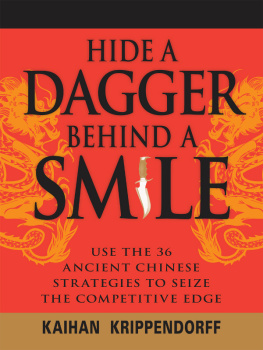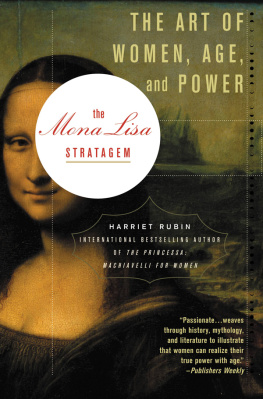HIDE A
DAGGER
BEHIND A
SMILE
USE THE 36
ANCIENT CHINESE
STRATEGIES TO SEIZE
THE COMPETITIVE EDGE
KAIHAN KRIPPENDORFF

Copyright 2008 by Kaihan Krippendorff
All rights reserved.
This book, or parts thereof, may not be reproduced in any
form without permission from the publisher; exceptions are
made for brief excerpts used in published reviews.
Published by
Adams Media, an F+W Publications Company
57 Littlefield Street, Avon, MA 02322. U.S.A.
www.adamsmedia.com
ISBN-10: 1-59869-380-8
ISBN-13: 978-1-59869-380-5
eISBN: 978-1-44051-450-0
Printed in the United States of America.
J I H G F E D C B A
Library of Congress Cataloging-in-Publication Data
Krippendorff, Kaihan.
Hide a dagger behind a smile / Kaihan Krippendorff.
p. cm.
Based on concepts from the ancient Chinese text,
The Secret art of war : the 36 stratagems.
Includes bibliographical references.
ISBN-13: 978-1-59869-380-5 (pbk.)
ISBN-10: 1-59869-380-8 (pbk.)
1. CompetitionManagementCase studies. 2. San shi
liu ji. 3. StrategyCase studies. 4. Problem solvingCase
studies. 5. Industrial managementCase studies. I. Title.
HD41.K69 2007
658.4012dc22
2007039126
This publication is designed to provide accurate and authoritative information with regard to the subject matter covered. It is sold with the understanding that the publisher is not engaged in rendering legal, accounting, or other professional advice. If legal advice or other expert assistance is required, the services of a competent professional person should be sought.
From a Declaration of Principles jointly adopted by a Committee of the
American Bar Association and a Committee of Publishers and Associations
Many of the designations used by manufacturers and sellers to distinguish their product are claimed as trademarks. Where those designations appear in this book and Adams Media was aware of a trademark claim, the designations have been printed with initial capital letters.
This book is available at quantity discounts for bulk purchases.
For information, please call 1-800-289-0963.
CONTENTS
PART I
YIN YANG POLARITY
STRATAGEM ONE
To Catch Something, First Let It Go
STRATAGEM TWO
Exchange a Brick for a Jade
STRATAGEM THREE
Invite Your Enemy onto the Roof, Then Remove the Ladder
STRATAGEM FOUR
Lure the Tiger Down from the Mountain
STRATAGEM FIVE
Befriend the Distant Enemy to Attack One Nearby
STRATAGEM SIX
Kill with a Borrowed Knife
STRATAGEM SEVEN
Besiege Wei to Rescue Zhao
STRATAGEM EIGHT
The Stratagem of Sowing Discord
STRATAGEM NINE
Trouble the Water to Catch the Fish
PART II
WU WEI: GO WITH THE FLOW
STRATAGEM TEN
Remove the Firewood from under the Pot
STRATAGEM ELEVEN
Shut the Door to Capture the Thief
STRATAGEM TWELVE
Replace the Beams with Rotten Timbers
STRATAGEM THIRTEEN
The Stratagem of the Beautiful Woman
STRATAGEM FOURTEEN
Beat the Grass to Startle the Snake
STRATAGEM FIFTEEN
Loot a Burning House
STRATAGEM SIXTEEN
Sometimes Running Away Is the Best Strategy
STRATAGEM SEVENTEEN
Seize the Opportunity to Lead the Sheep Away
STRATAGEM EIGHTEEN
Feign Madness but Keep Your Balance
PART III
WU CHANG: CONTINUOUS CHANGE
STRATAGEM NINETEEN
Watch the Fire on the Other Shore
STRATAGEM TWENTY
Let the Plum Tree Wither in Place of the Peach
STRATAGEM TWENTY-ONE
The Stratagem of the Open City Gates
STRATAGEM TWENTY-TWO
Await the Exhausted Enemy at Your Ease
STRATAGEM TWENTY-THREE
Exchange the Role of Guest for That of Host
STRATAGEM TWENTY-FOUR
Borrow the Road to Conquer Gao
STRATAGEM TWENTY-FIVE
Shed Your Skin Like the Golden Cicada
STRATAGEM TWENTY-SIX
The Stratagem of Injuring Yourself
STRATAGEM TWENTY-SEVEN
Borrow a Corpse for the Souls Return
PART IV
SHANG BING WU BING: INDIRECT ACTION
STRATAGEM TWENTY-EIGHT
Point at the Mulberry but Curse the Locust
STRATAGEM TWENTY-NINE
Clamor in the East; Attack to the West
STRATAGEM THIRTY
Openly Repair the Walkway, Secretly March to Chen Cang
STRATAGEM THIRTY-ONE
Fool the Emperor and Cross the Sea
STRATAGEM THIRTY-TWO
Create Something out of Nothing
STRATAGEM THIRTY-THREE
Hide a Dagger Behind a Smile
STRATAGEM THIRTY-FOUR
Deck the Tree with Bogus Blossoms
STRATAGEM THIRTY-FIVE
To Catch the Bandits, Capture Their Leader
STRATAGEM THIRTY-SIX
The Stratagem of Linking Stratagems
APPENDIX A
The Thirty-Six Stratagems as Problem-Solving Tools
APPENDIX B
Rapid-Cycle Strategy Innovation
APPENDIX C
Research
ACKNOWLEDGMENTS
The book is like a snapshot of a conversation I have been holding with many like-minded people over the past ten years. I unfortunately only have space here to thank a portion of this community. Above all I thank my wife, Pilar Ramos, and my son, Lucas Somar Krippendorff, for being the purpose of me completing this book.
Dr. Kathryn Harrigan, my professor at Columbia Business School, first encouraged me with the idea that I could write a book. Others who provided academic support include Dr. Ming-Jer Chen, Dr. Costas Markides (London Business School), Dr. Sumantra Ghoshal (now deceased, London Business School), Dr. Steve Heine (Florida International University), Dr. Alan Carsud (Florida International University). I thank my father, Dr. Klaus Krippendorff (University of Pennsylvania), for expanding my thinking over countless engaging conversations.
My colleagues at The Strategy Learning Center, especially AnaMaria Rivera, contributed ideas and support the research. This work is far more powerful thanks to the case ideas and insights shared by Doug Muir, Ruedi Mller, Verne Harnish, Zaki Mustafa, Stephannie Wasserstein, Ned Bowman, Tereza Sommerfeld, Enrique Riquelme, Evan Shelan, and Maritza Morales. My former colleagues at McKinsey & Company continue to serve as mentors and friends, including David Wenner, Jacques Antebi, Juan-Jose Gonzalez, Brad Hoover, Tim Lukes, and Joanna Popper.
In my attempt to capture the subtleties of the Thirty-Six Stratagems as accurately as I can, I depended heavily on a small network of generous friends. Qin Chen spent countless hours with me explaining and critiquing my interpretation of each stratagem. I first asked Christina Zhu about the stratagems in 1999. She has continued to answer my questions energetically. Teresa Chu, Harry Wang, and Alex Tsui helped keep my interpretation of the Chinese philosophy behind each stratagem on target.
I also thank my mother, Sultana Alam, for inspiring me and my agent, Laurie Harper, for guiding me.
Kaihan Krippendorff
Miami, Florida
February 2007
PREFACE
I n March 1220 AD, the defenders of Bukhara made a fatal mistake. This ancient Muslim city in what is now Uzbekistan was about to fall prey to one of historys most daring military maneuvers. Genghis Khan had appeared as if from thin air.
When he first set his sights on Bukhara, he appeared to pursue a conventional approach, sending his army to attack cities standing between his homeland, Mongolia, and his target. But while the defenders of Bukhara monitored their adversarys progress, Genghis Khan secretly prepared a detachment for a march most thought impossible. He drove his men farther than any army had ever covered across 2,000 miles of mountains, deserts, and plainsand appeared unexpectedly at Bukharas doorstep. Surprised, Bukhara swiftly joined a long list of cities outwitted by Genghis Khan.
Next page













